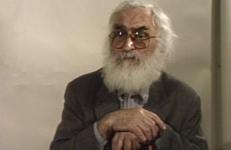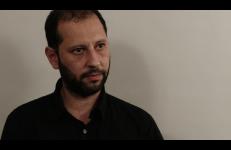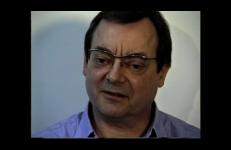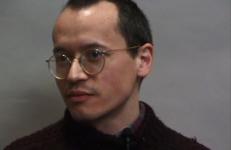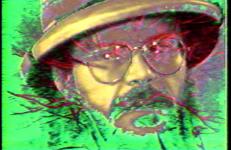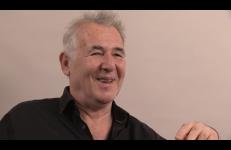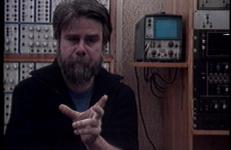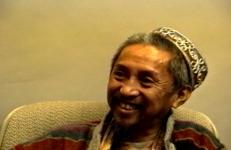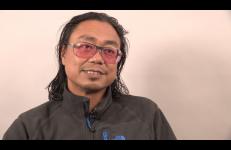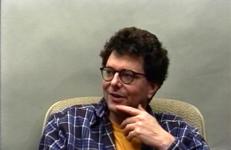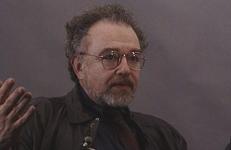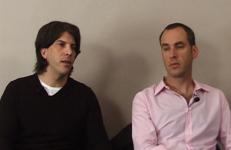Milton Resnick was born in Bratslav, Russia in 1917, and immigrated to the United States in 1922. Resnick was one of the few survivors of the second generation Abstract Expressionists, and is known for his large, thickly painted abstract canvases. Like other painters of the time, Resnick was striving for an overall quality to his paintings, a way to unite the foreground and background. While others moved toward throwing or dragging quantities of paint across the face of the canvas, Resnick retained a particularly personal and impassioned relation to brush painting.
VDB Interviews
In this interview with Melika Bass, a Chicago-based filmmaker and installation artist, Camilo Restrepo discusses how he became a filmmaker and how he chooses to document his native home of Colombia. After pursuing a degree in painting, Restrepo got a “regular job” but found himself pulled back towards creative pursuits. Equipped with a Super 8 camera, he set out to document his home honestly, and without an excess of materials.
In this interview painter Robert Ryman (b. 1930) describes his artistic influences, recounts his work process, and assesses the use and meaning of painting, both in the 1960s and the 1990s. For Ryman, the focus of his work is not politics or society, but the “problem of painting.” This interview sheds light not only on his method, which he calls an “intuitive approach,” but also on the artist’s ongoing investment in the physicality of scale, surface and materiality.
Joe Sacco is a cartoonist who has contributed to a wide range of comic magazines including Drawn and Quarterly, Prime Cuts, Real Stuff, Buzzard, and R. Crumb’s Weirdo; he continues to illustrate the semi-regular Painfully Portland cartoon strip for the Willamette Week. He was a recipient of the prestigious American Book Award in 1996 for his work Palestine (1996), which combines techniques of eyewitness reportage with comic strip storytelling.
Juan Sanchez explores his Puerto Rican heritage and the issue of Puerto Rican independence through his work as an artist and writer. Combining painting, photography, collage, and printmaking techniques, Sanchez’s art joins images of contemporary barrio life with memories of Puerto Rico, and addresses a fragmented Latino community fraught with political resistance and cultural alienation.
Interview by Bibiana Suarez.
A historical interview originally recorded in 1990.
Dan Sandin designed the Image Processor that, partly because of his decision to give away the building plans, has effected an energetic and aesthetic investigation of the technological structures of electronic media. He sees the Image Processor as both an event and an environment for artists to explore and experience. During the interview, Sandin spontaneously synthesizes his own image.
Interview by John Manning. Shot by Christine DeLignieres.
A historical interview originally recorded in 1980.
This interview depicts American writer, activist, and AIDS historian Sarah Schulman (b. 1958), discussing becoming a writer, her novels, and her long-term collaboration with filmmaker James Hubbard on projects devoted to gay liberation and AIDS activism. Born in New York to a Holocaust-surviving family, Schulman grew up in an era where women were not considered important.
Richard Schechner is Professor of Performance Studies at New York University, author of numerous books including Performance Theory (1988) and The Future of Ritual (1993), and editor of The Drama Review. This interview with Nancy Forest Brown was conducted during an event at the School of the Art Institute of Chicago.
In this interview, Indian artist Shuddhabrata Sengupta (b. 1968) discusses his role in the initiation of the Raqs Media Collective, a Delhi-based artist collective, active since the 1990s. At the time of this interview, Raqs had been creating documentaries, art installations, and educational programs for eighteen years. Sengupta likens the driving force of Raqs to that of a game of catch, a process generated by a back-and-forth dialogue mobilized through writing and in-person meetings. As children of the late sixties, Sengupta explains how and why the members of Raqs, (himself, Jeebesh Bagchi and Monica Narula) share an interest in investigating mass communication, technologies of visibility, and the significance of memory and travel. It is also for this reason, Sengjupta explains, that the Collective’s work is committed to fostering rigorous research in addition to art-making endeavors.
John Smith, throughout his 40-year career, has approached the moving image from film, video and installations, generating a tremendous body of work that’s as diverse in its topics as it is in its methods. Weaving between early structuralist film and more personal, diaristic, documentary approaches to the places in which he lived, most notably London, his output is both broad and varied.
Bob Snyder is a Chicago-based composer, video artist, and author who has been experimenting with sound and video synthesis since the 1960s. As a musician, his interest has always been in the relationship between music and visual imagery. In Snyder’s work, music is the central generative source of meaning, although he also creates a dialogue between the sound and images of nature and architecture.
Interview by Rafael Franca.
Art Spiegelman was born and raised in New York, and began working as a cartoonist while still in High School. He attended the State University of New York in Binghamton, where he studied Philosophy. Spiegelman, who continued to work as a cartoonist, mainly in underground publications, throughout his schooling, has long been acknowledged as one of our era's foremost comic book artists. However, it was Maus, published in two volumes in 1986, that first brought his work to a mass audience. Maus tells the stories of a Jewish survivor of Nazi Germany and his son.
Pat Steir is an American painter and printmaker whose work has resisted artworld currents and factions for decades, while expanding its reach and maintaining enthusiastic critical support. She graduated from Pratt in 1962, and in 1964 was included in the show Drawing at the Museum of Modern Art in New York and had her first solo exhibition at the Terry Dintenfass Gallery, New York.
John Tagg is a writer, educator, and a leading contributor to the development of art-historical and photographic theory, focusing on political analysis of institutionalized culture and interventions within it. He is a professor of art history at State University of New York-Binghamton and author of Grounds of Dispute: Art History, Cultural Politics and the Discursive Field (1992) and The Burden of Representation: Essays on Photographies and Histories (1988). Interview by James Hugunin.
A historical interview originally recorded in 1988.
Kidlat Tahimik is a Filipino filmmaker, writer and actor who takes his name from the Tagalog translation of “silent lightning.” Known as the “Father of Philippine Independent Cinema,” his contemplative films are associated with the Third Cinema movement for their examination of neocolonialism and the Hollywood business-model of filmmaking.
Parry Teasdale is one of the founding members of the video art collective Videofreex, which was active in the 1960s and 70s. In this extensive two-part interview Teasdale explores the collective’s motivations and endeavors, which embodied the social and political concerns of the period.
At the age of twenty-four, Taiwanese artist Tehching Hsieh (b.1950), moved to New York, where he has created and documented time-specific, conceptual art performances since the 1970s. In this interview, Hsieh discusses his formative years and philosophical moorings. This dialogue includes description of the artist’s early period of painting, his military service in Taiwan, and the cultural atmosphere of a country then undergoing massive political change. Much of the discussion focuses specifically on Hsieh’s understanding of the relationship of art and life, his investment in “free thinking,” and the politics of documentation. For Hsieh, the ability to think freely is art’s bottom line—he believes the essence of his work lies in human communication. To this end, Hsieh insists that his work, though incredibly personal, is not autobiographical, but philosophical.
Rirkrit Tiravanija’s work explores the social role of the artist, and that role’s ability to create interactive spaces for people to come together. Focusing less on the construction of discrete objects, he maintains a practice predicated on diffuse forms of installation that facilitate the activities like cooking, reading, and general collectivity. The particularly conceptual nature of his work is a central theme in this interview. While in art school, a teacher Tiravanija greatly admired told him to “stop making art” and this was something he took very seriously.
Danny Tisdale is a performance artist from New York City. His performances challenge prevailing ideas of race, assimilation, appropriation and success by offering passers-by the chance to racially change their appearance as a means to achieve greater financial success. The mimicry of museological practices of cataloguing and preservation, display and presentation provides one of a range of rhetorical frameworks upon which Danny Tisdale hangs his practice of social critique.
Fred Tomaselli’s mosaics and collages compose patterns and images that suggest ancient global influences. His materials, however, are products of modern consumption, addiction, bodily abuse, and pleasure: pills, nicotine patches, bandages, and the like. The surfaces are coated with a lacquered veneer, making these mundane sources of highs or healing gleam. Interview by James Rondeau. A historical interview originally recorded in 1999 and re-edited in 2007.
Allan Trachtenberg is one of the most esteemed figures in contemporary photographic history and cultural studies. He received an Andrew W. Mellon Foundation Emeritus Fellowship for his continuing work on Wright Morris. Other honors include fellowships from the American Council of Learned Societies, the National Endowment for the Humanities, the Rockefeller Foundation and the Guggenheim Foundation. Trachtenberg is the Neil Gray, Jr. Professor Emeritus of English and American studies at Yale University, where he taught for thirty-five years.
In this interview, Los Angeles-based artist and filmmaker Ryan Trecartin (b. 1981) discusses his personal interests and motivations, as well as the larger cultural and philosophical concerns that shape his videos and their reception. Trecartin is known for his construction of non-linear narratives, campy costumes, and excessively visceral characters and environments. One of the most compelling aspects of this interview is his insistence that language and its verbal articulation, rather than the visual, anchor his process. Trecartin identifies the influences of 1990s retro-rave culture, hip-hop videos, and editing software tools on his work. He notes that the accelerated disintegration of high and low culture has played a major part in his growth as an artist.
Originally trained as a musical composer, receiving her MFA and Ph.D. from the University of Illinois, Champaign-Urbana, Trinh T. Minh-ha (b. 1952) is a world-renowned documentary feminist filmmaker and expert on avant-garde and third world post-colonial film theory. In 1970, Minh-ha came to the United States from Vietnam at the age of seventeen. Since then she has been involved in film, musical composition, social theory, and critical writing.
Wu Tsang is a filmmaker, visual artist, and performer who incorporates strategies of activism, art making, event planning, and stage production across a range of multi-disciplinary projects. Tsang combines or juxtaposes the avant-garde and cerebral with sensual, often emotionally charged representations that prompt deeper inquiries into how individuals and communities resist ingrained social prejudices.
“Collaboration is competitive” – this is the tag line for the artist collective Type A, composed of Adam Ames and Andrew Bordwin. Their projects stretch across the mediums of video, photography, sculpture, and installation – using different formats less for their own sake and more for their appropriateness in relation to a given idea. This malleability allows them to stage installations that are more like interventions in various non-art spaces such as the city streets or a high school gym.




